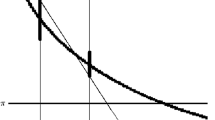Abstract
Infinitesimal perturbation analysis and score function gradient estimators are developed for PERT (Program Evaluation and Review Technique) networks and analyzed for potential use for prescriptive project management. In particular, a stochastic version of the familiar deterministic “project crashing” problem is considered. A heuristic using the gradient estimators is developed and shown to give close to locally optimal performance relatively quickly. An attempt is made to characterize the amount of variability in networks that would warrant the use of this heuristic by comparing its performance experimentally to that of the standard linear programming approach using only the task means (ignoring variability).
Similar content being viewed by others
Referees
V.G. Adlakha, An empirical evaluation of antithetic variates and quasirandom points for simulating stochastic networks, Simulation 58(1992).
V.G. Adlakha, An improved conditional Monte Carlo technique for stochastic shortest route problems, Manag. Sci. 32(1986)1360–1367.
V.M. Aleksandrov, V.I. Sysoyev and V.V. Shemeneva, Stochastic optimization, Eng. Cybern. 5(1968)11–16.
J.F. Bard and J.E. Bennett, Path preference in stochastic acyclic networks, Manag. Sci. 37(1991)198–215.
R.A. Bowman, Efficient estimation of arc criticalities in stochastic activity networks, Working Paper, Graduate Management Institute, Union College, Schenectady, NY (1991), to appear in Manag. Sci.
R.A. Bowman, Parameter selection for stochastic PERT time-cost tradeoffs, Working Paper, Graduate Management Institute, Union College, Schenectady, NY (1992).
R.A. Bowman and J.A. Muckstadt, Stochastic analysis of cyclic schedules, Technical Report No. 941, School of OR and IE, Cornell University, Ithaca, NY (1990), to appear in Oper. Res.
J.M. Burt and M.B. Garman, Conditional Monte Carlo: A simulation technique for stochastic network analysis, Manag. Sci. 18(1971).
R.C.H. Cheng, The use of antithetic control variates in computer simulations, in:Proc. 1981 Winter Simulation Conf., ed. T.I. Ören, C.M. Delfosse and C.M. Schub (1981).
R. Dial, F. Glover, D. Karney and D. Klingman, A computational analysis of alternative algorithms for finding shortest path trees, Research Report No. CCS 291, University of Texas (1977).
B.M. Dodin, Bounding the project completion time distribution in PERT networks, Oper. Res. 33(1985)862–881.
S.E. Elmaghraby,Activity Networks: Project Planning and Control by Network Models (Wiley, New York, 1977).
G.S. Fishman, Estimating critical path and arc probabilities in stochastic activity networks, Technical Report No. ONC/ORSA/TR-83/5, University of North Carolina at Chapel Hill (1983).
G.S. Fishman, Estimating network characteristics in stochastic activity networks, Manag. Sci. 31(1985)579–593.
G.A. Forgionne, Corporate management science activities: An update, Interfaces 13(1983)20–23.
M.C. Fu and J.Q. Hu, Extensions and generalizations of smoothed perturbation analysis in a generalized semi-Markov process framework, IEEE Trans. Auto. Contr. AC-37(1992)1483–1500.
D.R. Fulkerson, A network flow computation for project cost curve, Manag. Sci. 7(1961)167–178.
P. Glasserman,Gradient Estimation via Perturbation Analysis (Kluwer Academic, 1991).
P. Glasserman, Structural conditions for perturbation analysis derivative estimation: Finite time performance indices, Oper. Res. 39(1991)724–738.
P. Glasserman and W.B. Gong, Smoothed perturbation analysis for a class of discrete event systems, IEEE Trans. Auto. Contr. AC-35(1990)1218–1230.
P.W. Glynn, Stochastic approximation for Monte Carlo optimization, in:Proc. 1986 Winter Simulation Conf. (IEEE Press, 1986) pp. 356–364.
P.W. Glynn, LIkelihood ratio gradient estimation: An overview, in:Proc. 1987 Winter Simulation Conf. (IEEE Press, 1987) pp. 366–375.
P.W. Glynn, Likelihood ratio gradient estimation for stochastic systems, Commun. ACM 33(1990)75–84.
W.B. Gong and Y.C. Ho, Smoothed perturbation analysis of discrete event dynamical systems, IEEE Trans. Auto. Contr. AC-32(1987)858–866.
Y.C. Ho, M.A. Eyler and T.T. Chien, A gradient technique for general buffer storage design in a serial production line, Int. J. Prod. Res. 7(1979)557–580.
Y.C. Ho and X.R. Cao,Discrete Event Dynamic Systems and Perturbation Analysis (Kluwer Academic, 1991).
A.M. Law and W.D. Kelton,Simulation Modeling and Analysis (McGraw-Hill, New York, 1991).
P. L'Ecuyer, A unified view of the IPA, SF, and LR gradient estimation techniques, Manag. Sci. 36(1990)1364–1383.
P. L'Ecuyer, An overview of derivative estimation, in:Proc. 1991 Winter Simulation Conf. (IEEE Press, 1991) pp. 207–217.
J.J. Martin, Distribution of time through a directed acyclic network, Oper. Res. 13(1965)46–66.
M.I. Reiman and A. Weiss, Sensitivity analysis for simulations via likelihood ratios, Oper. Res. 37(1989)830–844.
R.Y. Rubinstein, Sensitivity analysis and performance extrapolation for computer simulation models, Oper. Res. 37(1989)72–81.
R.Y. Rubinstein and A. Shapiro,Discrete-Event Systems: Sensitivity Analysis and Stochastic Optimization via the Score Function Method (Wiley, 1993).
C.E. Sigal, A.A.B. Pritsker and J.J. Solberg, The use of cutsets in Monte Carlo analysis of stochastic networks, Math. Comp. Simul. 21(1979)376–384.
R.M. Van Slyke, Monte Carlo methods and the PERT problem, Oper. Res. 11(1963)839–860.
Author information
Authors and Affiliations
Rights and permissions
About this article
Cite this article
Bowman, R.A. Stochastic gradient-based time-cost tradeoffs in PERT networks using simulation. Ann Oper Res 53, 533–551 (1994). https://doi.org/10.1007/BF02136842
Issue Date:
DOI: https://doi.org/10.1007/BF02136842




